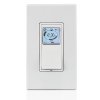We have two toggle switchers at our foyer. One controls the light inside, one for outside.
I bought a leviton timer switch(something like this )
)
But I got nothing on the screen after connecting all the wires.
Here's the image for before/after. IF I remove wire#1, my kitchen is out of power I'm not sure what's the purpose of wire#1 in the image. Maybe that's the reason?

I bought a leviton timer switch(something like this
 )
)But I got nothing on the screen after connecting all the wires.
Here's the image for before/after. IF I remove wire#1, my kitchen is out of power I'm not sure what's the purpose of wire#1 in the image. Maybe that's the reason?

Last edited:

